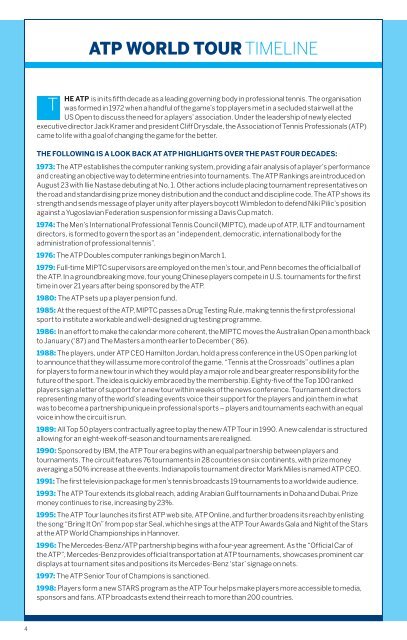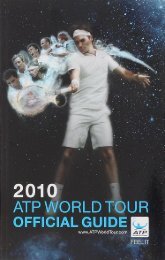2015 ATP World Tour Media Guide
www.tennismoscow.me Insta:TENNISMOSCOW
www.tennismoscow.me Insta:TENNISMOSCOW
Create successful ePaper yourself
Turn your PDF publications into a flip-book with our unique Google optimized e-Paper software.
atp world tour timeline<br />
t<br />
he <strong>ATP</strong> is in its fifth decade as a leading governing body in professional tennis. The organisation<br />
was formed in 1972 when a handful of the game’s top players met in a secluded stairwell at the<br />
US Open to discuss the need for a players’ association. Under the leadership of newly elected<br />
executive director Jack Kramer and president Cliff Drysdale, the Association of Tennis Professionals (<strong>ATP</strong>)<br />
came to life with a goal of changing the game for the better.<br />
The following is A look bAck AT <strong>ATP</strong> highlighTs over The PAsT four decAdes:<br />
1973: The <strong>ATP</strong> establishes the computer ranking system, providing a fair analysis of a player’s performance<br />
and creating an objective way to determine entries into tournaments. The <strong>ATP</strong> Rankings are introduced on<br />
August 23 with Ilie Nastase debuting at No. 1. Other actions include placing tournament representatives on<br />
the road and standardising prize money distribution and the conduct and discipline code. The <strong>ATP</strong> shows its<br />
strength and sends message of player unity after players boycott Wimbledon to defend Niki Pilic’s position<br />
against a Yugoslavian Federation suspension for missing a Davis Cup match.<br />
1974: The Men’s International Professional Tennis Council (MIPTC), made up of <strong>ATP</strong>, ILTF and tournament<br />
directors, is formed to govern the sport as an “independent, democratic, international body for the<br />
administration of professional tennis”.<br />
1976: The <strong>ATP</strong> Doubles computer rankings begin on March 1.<br />
1979: Full-time MIPTC supervisors are employed on the men’s tour, and Penn becomes the official ball of<br />
the <strong>ATP</strong>. In a groundbreaking move, four young Chinese players compete in U.S. tournaments for the first<br />
time in over 21 years after being sponsored by the <strong>ATP</strong>.<br />
1980: The <strong>ATP</strong> sets up a player pension fund.<br />
1985: At the request of the <strong>ATP</strong>, MIPTC passes a Drug Testing Rule, making tennis the first professional<br />
sport to institute a workable and well-designed drug testing programme.<br />
1986: In an effort to make the calendar more coherent, the MIPTC moves the Australian Open a month back<br />
to January (‘87) and The Masters a month earlier to December (‘86).<br />
1988: The players, under <strong>ATP</strong> CEO Hamilton Jordan, hold a press conference in the US Open parking lot<br />
to announce that they will assume more control of the game. “Tennis at the Crossroads” outlines a plan<br />
for players to form a new tour in which they would play a major role and bear greater responsibility for the<br />
future of the sport. The idea is quickly embraced by the membership. Eighty-five of the Top 100 ranked<br />
players sign a letter of support for a new tour within weeks of the news conference. <strong>Tour</strong>nament directors<br />
representing many of the world’s leading events voice their support for the players and join them in what<br />
was to become a partnership unique in professional sports – players and tournaments each with an equal<br />
voice in how the circuit is run.<br />
1989: All Top 50 players contractually agree to play the new <strong>ATP</strong> <strong>Tour</strong> in 1990. A new calendar is structured<br />
allowing for an eight-week off-season and tournaments are realigned.<br />
1990: Sponsored by IBM, the <strong>ATP</strong> <strong>Tour</strong> era begins with an equal partnership between players and<br />
tournaments. The circuit features 76 tournaments in 28 countries on six continents, with prize money<br />
averaging a 50% increase at the events. Indianapolis tournament director Mark Miles is named <strong>ATP</strong> CEO.<br />
1991: The first television package for men’s tennis broadcasts 19 tournaments to a worldwide audience.<br />
1993: The <strong>ATP</strong> <strong>Tour</strong> extends its global reach, adding Arabian Gulf tournaments in Doha and Dubai. Prize<br />
money continues to rise, increasing by 23%.<br />
1995: The <strong>ATP</strong> <strong>Tour</strong> launches its first <strong>ATP</strong> web site, <strong>ATP</strong> Online, and further broadens its reach by enlisting<br />
the song “Bring It On” from pop star Seal, which he sings at the <strong>ATP</strong> <strong>Tour</strong> Awards Gala and Night of the Stars<br />
at the <strong>ATP</strong> <strong>World</strong> Championships in Hannover.<br />
1996: The Mercedes-Benz/<strong>ATP</strong> partnership begins with a four-year agreement. As the “Official Car of<br />
the <strong>ATP</strong>”, Mercedes-Benz provides official transportation at <strong>ATP</strong> tournaments, showcases prominent car<br />
displays at tournament sites and positions its Mercedes-Benz ‘star’ signage on nets.<br />
1997: The <strong>ATP</strong> Senior <strong>Tour</strong> of Champions is sanctioned.<br />
1998: Players form a new STARS program as the <strong>ATP</strong> <strong>Tour</strong> helps make players more accessible to media,<br />
sponsors and fans. <strong>ATP</strong> broadcasts extend their reach to more than 200 countries.<br />
4
















